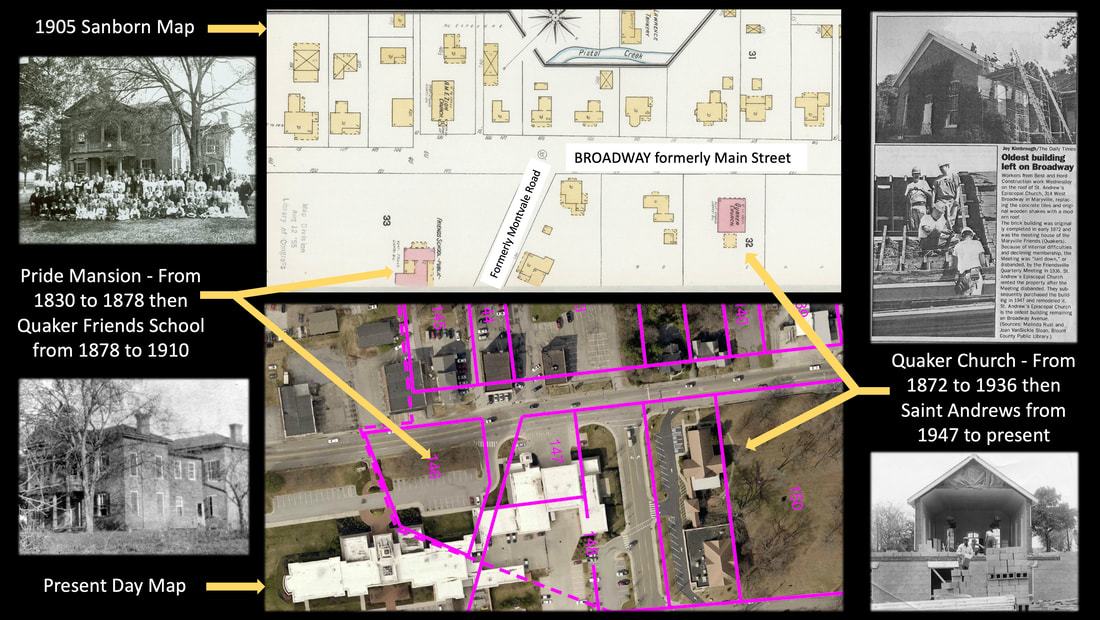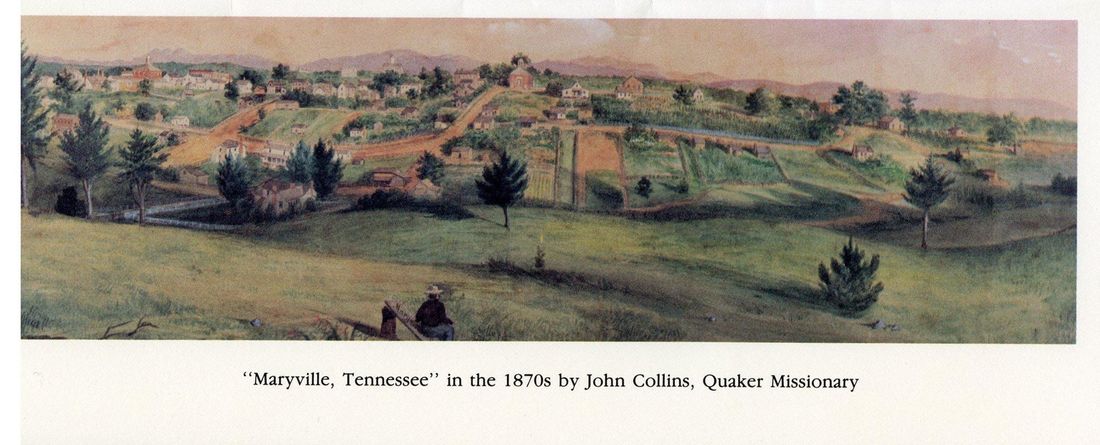City History Initiative
The Town of Maryville is currently in its 219th year being created on July 11, 1795. It is an understatement to say that tens of thousands of people have lived and died in Blount County and many experienced dramatic change. Dr. Samuel Pride is but one of those citizens who lived through a time of change, hardship and tragedy.
On January 7, 1850, the State of Tennessee’s General Assembly, Ch.17, Acts 1850, authorized “the inhabitants of any village, town or City in the State of Tennessee to form to themselves a body corporate, by such name and style as they shall select.” Providing for the annual election if seven Alderman and they in turn to elect one of their group as Mayor. This change in the incorporation laws allowed for a Mayor for the Town of Maryville and Dr. Samuel Pride was selected. My ancestor, Andrew McClain, was elected as one of the Alderman and served with Dr. Pride.
Dr. Samuel Pride was born on September 29, 1799 in the Toole’s Bend area of Knox County. Dr. Pride was descendant from the Virginia Prides, whose ancestors had settled in Virginia in the early 1630’s. He was described as being very handsome, tall with a dark head of hair, dark eyes, broad chin and very intelligent in keeping with his Virginia blueblood status. His early life was spent in Roane County, Tennessee and he received his education in Maryville. By 1829 he marries Martha Montgomery Sharp of Sevier County, Tennessee and they raise two children, John S. Pride and Mary Ann Pride.
He opened his office in Maryville in 1828 and became a very prominent citizen in the Blount County. He was a practicing physician, acting Justice of the Peace for many years, served as Chairman of the County Court in 1855, appointed Clerk and Master of the Chancery Court serving from 1853 to 1862, Trustee for Porter Academy, member of the New Providence Presbyterian Church, church Elder, Recorder of the Directors of Maryville College from 1827 to 1861 and Founder of the Medical Society of Tennessee. He also built a palatial home in 1852 referred to as the Pride Mansion.
Dr. Pride along with William Wallace and Hiram Heartsill headed a committee of 50 men to hold a barbecue honoring U. S. Senator Sam Houston who was passing through his childhood home of in August of 1845. During the Civil War, he also brokered a purchase of 5,000 bushels of salt from the Salt Works in Virginia for Blount County. Salt was very hard to come by because southern ports were blockaded.
On January 7, 1850, the State of Tennessee’s General Assembly, Ch.17, Acts 1850, authorized “the inhabitants of any village, town or City in the State of Tennessee to form to themselves a body corporate, by such name and style as they shall select.” Providing for the annual election if seven Alderman and they in turn to elect one of their group as Mayor. This change in the incorporation laws allowed for a Mayor for the Town of Maryville and Dr. Samuel Pride was selected. My ancestor, Andrew McClain, was elected as one of the Alderman and served with Dr. Pride.
Dr. Samuel Pride was born on September 29, 1799 in the Toole’s Bend area of Knox County. Dr. Pride was descendant from the Virginia Prides, whose ancestors had settled in Virginia in the early 1630’s. He was described as being very handsome, tall with a dark head of hair, dark eyes, broad chin and very intelligent in keeping with his Virginia blueblood status. His early life was spent in Roane County, Tennessee and he received his education in Maryville. By 1829 he marries Martha Montgomery Sharp of Sevier County, Tennessee and they raise two children, John S. Pride and Mary Ann Pride.
He opened his office in Maryville in 1828 and became a very prominent citizen in the Blount County. He was a practicing physician, acting Justice of the Peace for many years, served as Chairman of the County Court in 1855, appointed Clerk and Master of the Chancery Court serving from 1853 to 1862, Trustee for Porter Academy, member of the New Providence Presbyterian Church, church Elder, Recorder of the Directors of Maryville College from 1827 to 1861 and Founder of the Medical Society of Tennessee. He also built a palatial home in 1852 referred to as the Pride Mansion.
Dr. Pride along with William Wallace and Hiram Heartsill headed a committee of 50 men to hold a barbecue honoring U. S. Senator Sam Houston who was passing through his childhood home of in August of 1845. During the Civil War, he also brokered a purchase of 5,000 bushels of salt from the Salt Works in Virginia for Blount County. Salt was very hard to come by because southern ports were blockaded.
So, as you can see, Dr. Pride was a very active and respected citizen in the community. But life for Dr. Pride and his family would be forever shattered as the Civil War divided the nation, states, towns and families. The Civil War would utterly destroy the family of Dr. Pride.
The Civil War would split the country apart over the issue of state’s rights to govern themselves particularly in regard to slavery. Dr. Pride was very much a secessionist. One of the slaves that Dr. Pride owned was Henry (Thompson) Pride who was served as driver and household servant for the Pride family from 1853 to 1864 when Henry was drafted into the Union Army. Henry was nine when purchased by Dr. Pride for $900 and twenty when conscripted to serve in the First U.S. Colored Heavy Artillery Unit.
Dr. Pride did not hide his Confederate feelings and just before the Civil War broke out, he, John E. Toole and Jesse G. Wallace convened a large crowd in Maryville to air out grievances against the newly elected president, Abraham Lincoln, and his republican party. This was the beginning of the end for Dr. Pride. His strong conviction and his willingness to make them known brought much scrutiny to him, his friends, and his family. By 1863, conditions in Maryville were deplorable and tensions ran high. Dr. Pride no longer felt safe in his hometown and left for Georgia to serve the wounded at the battle of Chickamauga. While there, he contracted typhoid pneumonia and died at the age of 64.
Dr. Pride’s family, like many East Tennessee confederate families including some of my relatives, left for other communities at the close of the Civil War. Martha Pride and her children and grandchildren left for Williamson County, Tennessee never to return to their beloved Maryville.
Dr. Pride’s final words to Martha and his family came by letter dated just days before his death on October 25, 1863. Pride writes “Ah My Dear never has my attachment of you been so keenly felt or my desire for your comfort and happiness so deeply impressed as since our separation. And now My Dear for yourself accept assurance of my most devoted and undivided affection and look constantly to God for protection and help and such shall be the unceasing prayer of your husband. Affectionately, Sam Pride.”
The Civil War would split the country apart over the issue of state’s rights to govern themselves particularly in regard to slavery. Dr. Pride was very much a secessionist. One of the slaves that Dr. Pride owned was Henry (Thompson) Pride who was served as driver and household servant for the Pride family from 1853 to 1864 when Henry was drafted into the Union Army. Henry was nine when purchased by Dr. Pride for $900 and twenty when conscripted to serve in the First U.S. Colored Heavy Artillery Unit.
Dr. Pride did not hide his Confederate feelings and just before the Civil War broke out, he, John E. Toole and Jesse G. Wallace convened a large crowd in Maryville to air out grievances against the newly elected president, Abraham Lincoln, and his republican party. This was the beginning of the end for Dr. Pride. His strong conviction and his willingness to make them known brought much scrutiny to him, his friends, and his family. By 1863, conditions in Maryville were deplorable and tensions ran high. Dr. Pride no longer felt safe in his hometown and left for Georgia to serve the wounded at the battle of Chickamauga. While there, he contracted typhoid pneumonia and died at the age of 64.
Dr. Pride’s family, like many East Tennessee confederate families including some of my relatives, left for other communities at the close of the Civil War. Martha Pride and her children and grandchildren left for Williamson County, Tennessee never to return to their beloved Maryville.
Dr. Pride’s final words to Martha and his family came by letter dated just days before his death on October 25, 1863. Pride writes “Ah My Dear never has my attachment of you been so keenly felt or my desire for your comfort and happiness so deeply impressed as since our separation. And now My Dear for yourself accept assurance of my most devoted and undivided affection and look constantly to God for protection and help and such shall be the unceasing prayer of your husband. Affectionately, Sam Pride.”
History of the City of Maryville
Thank you for your interest in the history of the City. We are currently working on compiling a wealth of photos and information to provide you with a great deal of insight into the history and identity of the city of Maryville. We look forward to sharing that with you soon.
City of Maryville Historical Timeline
In 1995 for the bicentennial celebration, staff member David Morton compiled an interesting historical timeline with the perspective of national and world history. Download this pdf to read more about the history of the City.
Brief overview of the City's history
Fort Craig, which was located on Pistol Creek, was the first settlement in the area which is now the City of Maryville. The fort was built in 1785 to protect settlers from Indian attack. In 1786, the first church was established and constructed of hewn logs.
The City of Maryville was established on July 11, 1795, by an act of the General Assembly of the Territory South of the Ohio River. Seven commissioners were appointed and were to obtain fifty acres of land. These fifty acres were to be divided into lots and sold, with the proceeds to be used for construction of a courthouse and jail. One reason for locating the town in this particular area was the abundance of springs for a water supply. Located in Blount County, Maryville was named in honor of Mary Grainger Blount, wife of Governor William Blount. The county was named in honor of Governor Blount. Almost a year later, on June 1, 1796, the State of Tennessee became the 16th state in the Union.
In 1819, Southern and Western Theological Seminary was opened. The name was changed to Maryville College in 1842.
During the Civil War, much of Maryville was damaged by fire and artillery. In one instance, a fire was set to try to flush Union soldiers from the courthouse then located on Broadway. The courthouse was spared, but many buildings surrounding it were destroyed.
The first railroad, the Knoxville and Charleston, was built into Maryville in 1868. In the late 1870's, Maryville acquired and opened its first public school. The first electric system was started in 1890 by Maryville Woolen Mills. In 1906, a branch line of the Louisville and Nashville Railroad arrived in Maryville.
The first water system was completed in 1916, being constructed of cast iron lines. About a year later, the first sanitary sewer system was completed. In 1956, the water filtration plant on Sevierville Road was put into operation.
Like many downtowns throughout the nation, development of contemporary malls and the proliferation of shopping centers lured businesses and customers away from the downtown area. However, unlike many other downtowns in the U.S. that have been lost, dozens of historic structures in downtown Maryville remain and have enjoyed continuous use, or have been rehabilitated recently. Currently, Maryville's downtown offers the community and visitors entertainment, office, restaurant, retail, recreation, government, education and religious institutions, medical, and housing opportunities. In addition, the Blount County Library and scheduled community programs further improves the downtown's position in attracting individuals and families. The city of Maryville has obtained a variety of grants used for road and sidewalk improvements, safe and attractive lighting, benches, two small parks, landscaping and informative signage. The City and participating community businesses also sponsor numerous events downtown that add to the use and enjoyment of the downtown area.
The population of Maryville is more than 27,000, and the town encompasses approximately16 square miles. The staff of the city of Maryville is proud of the accomplishments of its citizens and elected officials for the leadership and work toward providing an excellent quality of life for the community.
The City of Maryville was established on July 11, 1795, by an act of the General Assembly of the Territory South of the Ohio River. Seven commissioners were appointed and were to obtain fifty acres of land. These fifty acres were to be divided into lots and sold, with the proceeds to be used for construction of a courthouse and jail. One reason for locating the town in this particular area was the abundance of springs for a water supply. Located in Blount County, Maryville was named in honor of Mary Grainger Blount, wife of Governor William Blount. The county was named in honor of Governor Blount. Almost a year later, on June 1, 1796, the State of Tennessee became the 16th state in the Union.
In 1819, Southern and Western Theological Seminary was opened. The name was changed to Maryville College in 1842.
During the Civil War, much of Maryville was damaged by fire and artillery. In one instance, a fire was set to try to flush Union soldiers from the courthouse then located on Broadway. The courthouse was spared, but many buildings surrounding it were destroyed.
The first railroad, the Knoxville and Charleston, was built into Maryville in 1868. In the late 1870's, Maryville acquired and opened its first public school. The first electric system was started in 1890 by Maryville Woolen Mills. In 1906, a branch line of the Louisville and Nashville Railroad arrived in Maryville.
The first water system was completed in 1916, being constructed of cast iron lines. About a year later, the first sanitary sewer system was completed. In 1956, the water filtration plant on Sevierville Road was put into operation.
Like many downtowns throughout the nation, development of contemporary malls and the proliferation of shopping centers lured businesses and customers away from the downtown area. However, unlike many other downtowns in the U.S. that have been lost, dozens of historic structures in downtown Maryville remain and have enjoyed continuous use, or have been rehabilitated recently. Currently, Maryville's downtown offers the community and visitors entertainment, office, restaurant, retail, recreation, government, education and religious institutions, medical, and housing opportunities. In addition, the Blount County Library and scheduled community programs further improves the downtown's position in attracting individuals and families. The city of Maryville has obtained a variety of grants used for road and sidewalk improvements, safe and attractive lighting, benches, two small parks, landscaping and informative signage. The City and participating community businesses also sponsor numerous events downtown that add to the use and enjoyment of the downtown area.
The population of Maryville is more than 27,000, and the town encompasses approximately16 square miles. The staff of the city of Maryville is proud of the accomplishments of its citizens and elected officials for the leadership and work toward providing an excellent quality of life for the community.
Maryville's Mayors
|
1850-1852
1852 1852-1853 1853-1854 1854 1854-1855 1855-1856 1856-1857 1857 1857-1860 1860-1867 1867-1868 1868-1869 1869 1869-1870 1870-1872 1872-1874 1874-1876 1876-1877 1877-1879 |
Dr. Samuel Pride
Samuel Bicknell John Toole William D. McGinley Andrew McClain Julius Ceasar Fagg Isaac N. Hair William Cummings James Houston William D. McGinley Frank M. Hood Moses Lamar McConnell William Thomas Parham James A. Goddard William B. Scott John Currin Dr. Ben A. Morton William Thomas Parham Robert N. Hood James A. Greer |
Vertical Divider
|
1907-1909 1909-1911 1911-1913 1913-1919 1919-1921 1921-1929 1929-1939 1939-1947 1947-1953 1953-1961 1961-1965 1965-1967 1967-1999 1999-2003 2003-2008 2008-2020 2021- |
Andrew K. Harper Roll H. Hanna Andrew K. Harper Samuel Martin Everett David Franklin Young James A. "Tobe" Cox Arthur R. "Roll" McCammon Dr. Andrew McTeer Gamble John Calvin Crawford, Jr. Dr. Lea Callaway Sam Huffine Roberson Thomas Ned Lee Stanley Bernard "Skeeter" Shields Steve West Joe Swann Tom Taylor Andy White |
*Maryville was unincorporated in 1879 and remained as such until 1907.




